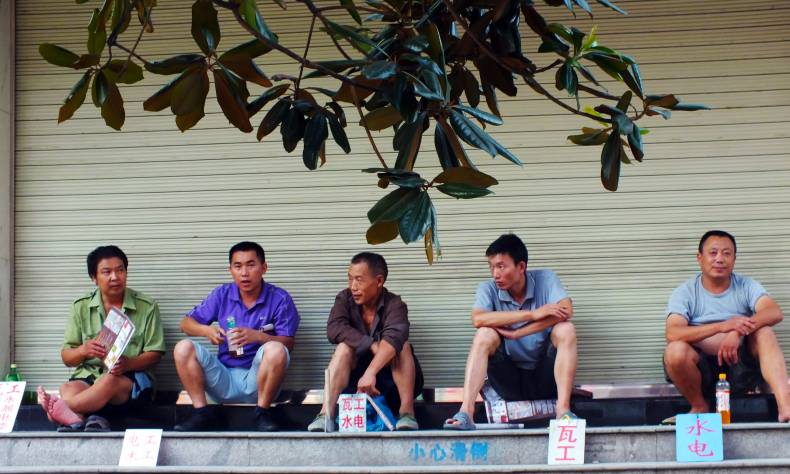
Unemployment a Concern for 2016 as Chinese Economy Slows
Unemployed Chinese migrant workers sit on a set of steps in Yichang, Hubei Province, and advertise their various skill-sets (bricklaying, water and electricity) as they look for work.
4.1 percent in perpetuity, give or take. That has been the Chinese government’s official figure for unemployment for the past decade or so despite an economic slowdown that has seen GDP growth tumble from a high of 14.9 percent in the second quarter of 2007 to the most recent reporting of 6.9 percent in the third quarter of last year. For those interested, this is what such a relationship looks like:
It should be noted that when referring to China’s officially given unemployment rate, the figure denotes unemployment in China’s urban areas only. This is due to the difficulties of data collection in rural areas and the tracking of the country’s transient migrant worker population. In 2013, Chinese government officials began reporting the surveyed unemployment rate (of only 31 cities, but still), a methodology more in line with what is used in developed nations, and today that figure stands at 5.1 percent.
Growth is down, the country’s leaders have discussed openly the challenges ahead, and certain industries are finding it tougher than ever, yet unemployment remains as stable as always? Even the most optimistic data watcher might struggle to believe that. A January 2015 report from the Economist Intelligence Unit that was conducted in conjunction with the International Monetary Fund estimated China’s real unemployment rate at 6.3 percent in 2014, 6 percent in 2015, and 5.7 percent in 2016. So, the good news is that unemployment in China is trending down, depending on who is asked.
And there will be eternal optimists and grumbling cynics no matter where one looks when it comes to China. Prognosticating on the world’s second-largest economy has become de rigeur by any and all with an eye on the global economy. Will China’s army of migrants move into its cities under the government’s ambitious urbanization schemes, or will the country’s collection of ghost cities grow larger with every passing quarter? That is the billion renminbi question.
What is a given, though, is that it’s going to be a difficult transition, as a number of recent labor protests in the Pearl River Delta of southern China, the country’s manufacturing hub, have demonstrated. Particular effort will need be paid to how the recent spate of labor problems are dealt with. The excellent Strike Map from the China Labor Bulletin out of Hong Kong shows that there were 242 labor-related strikes between July 2015 and the end of the year. Zoom in on Dongguan, a city famous for two things in China–one is manufacturing and the other less savory–shows the reasons for the protests: wage arrears, cutting of overtime, factory closures without compensation. And many of the situations end with the boss of the factory “running off.” It is a difficult situation that has come about because of the rising cost of labor in a slowing economy, but there is no excuse for these factory owners’ behavior. This is not how to treat those hardworking souls upon whose sweat and toil, not to mention time away from family, this country’s fortunes have been built. Looking to stand up for the rights of these migrants have been a number of NGOs and their staffers, but in December many of these advocates were arrested under what state news agency Xinhua called “disturbing social order.” The original Xinhua report (absent in English, but the gist covered here by the Global Times) accused Zeng Feiyang, head of the NGO Panyu Migrant Workers’ Center, and the NGO itself, of operating with overseas organizations and utilizing foreign funds for personal gain without giving further details.
Despite worker testimony that contradicts the Xinhua article by saying how Zeng informed the workers of rights they never knew they had and ensured that any disillusioned workers voiced their concerns within the letter of the law, these labor activists remain in jail, and that is obviously a problem. Because as the shift in the Chinese economy continues due to the rising cost of labor and stumbling sectors, factories are going to close or move to cheaper sources of production (such as nearby Vietnam) and these kinds of protests are going to become more common. It is all very well to strive for a harmonious society, but when real issues are painted over with thin veneer of stability, the potential remains for tough times ahead. It is better to talk with these workers and their leaders instead of ostracizing them by cutting down those who strive to help.
“Structural reform, especially cutting overcapacity, will inevitably affect the employment status and income of some people, but that’s a step we have to take,” Yang Weimin, deputy director of the Office of the Central Leading Group on Finance and Economic Affairs, told China Daily in the dying days of 2015, so it is not as though the authorities aren’t aware of the problem. And the government has already ordered the country’s state-owned enterprises to hire the 300,000 soldiers that will be laid off as part of the modernization of the military, so moves are being made to protect some of those who will soon be without work. But the protection needs to shift from the factory owners–a number likely with ties to local officials–ducking for cover as their businesses stumble to those who need government protection the most, the overworked transient workers existing on the margins of Chinese society.
 Facebook
Facebook
 Twitter
Twitter
 Linkedin
Linkedin
 Google +
Google +











